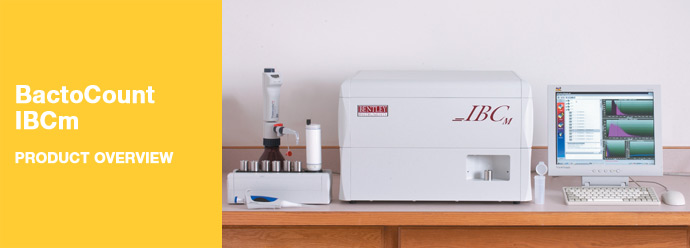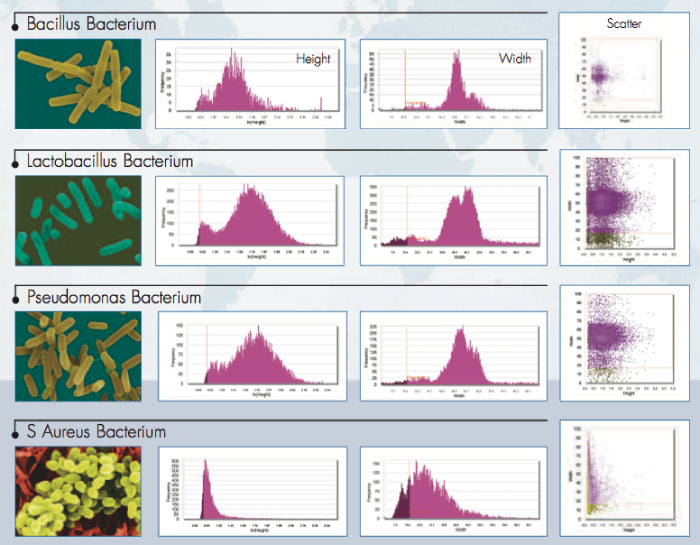
Rapid and Accurate Enumeration of Bacteria and Somatic Cells
Measures: total bacteria count and somatic cell count
The BactoCount IBCm is a semi-automated instrument that uses flow cytometry for the rapid enumeration of individual bacteria and somatic cells in milk. The rapid test for bacteria makes it an ideal solution for any processing plant or test laboratory involved in quality assessment on milk.
The IBCm is a general flow cytometer and its applications have been expanded to include the counting of somatic cells in raw milk. This gives a laboratory a convenient 2-for-1 solution when making laboratory investments.
- Analyzing time for bacterial count is less than one minute and sample preparation is completed in less than 10 minutes
- Analyzing time for somatic cell count is less than one minute, no sample preparation needed
- Use of a standard computer offers flexible data output options
- Easy operator-assisted sample preparation
- Low-maintenance design
Recognized by both NCIMS and MicroVal organizations. The BactoCount IBCm is based on the BactoCount IBC 50-150 models which have been approved as an alternative method to the IDF 100B:1991 reference method for the rapid and accurate determination of the hygienic quality of cow, sheep and buffalo raw milk for payment purposes. The IBC meets AOAC 986.33. Validated by MicroVal to be at least equivalent to the EN-ISO 4833-1:2013 and 4833-2:2013 reference methods for the enumeration of microorganisms in raw cow milk (Certificate n° 2013LR44)
Technical overview and principle of operation
The practical application varies slightly depending on whether it is somatic or bacterial cells that are counted but the general principle is the same: the cells are stained with a fluorescent dye that inserts into the intracellular DNA followed by detection and enumeration by a flow cytometry based cell counter.
The IBCm consists of three modules:
1. The counter
The counting assembly includes a powerful solid state laser, a flow cell, a set of optics, a narrow band filter, and a highly sensitive photo multiplier. The cells are aligned in the flow cytometer and exposed to an intense laser beam to excite the fluorescent marker intercalated into the intracellular DNA. The fluorescence pulses are collected with the optics, filtered with a narrow band filter, and detected with the photo multiplier. The pulses are sorted based on duration and intensity and then translated into individual bacteria counts (IBC’s) or somatic cell counts (SCC’s) depending on the chosen application. Using parallel results of IBC’s and traditional plate counts the instrument can be calibrated to output results in CFU/mL. Similarly, commercially available standards/reference samples with predetermined numbers of somatic cells can be paired with counts obtained with the IBCm to obtain the numbers in DMSCC/mL. (direct microscopic somatic cell count). The counting assembly is compact, enclosed and regulated at 30°C (86°F) to provide a highly stable environment.
2. The incubator
The main element of the incubator is a heated plate where six stainless steel vials can be placed side-by-side. The incubation plate is temperature regulated at 50°C (122°F) to optimize the process. The incubator also features a funnel-shaped slot to conveniently store the sonicator in for quick and easy access.
3. The computers
The IBCm is equipped with a powerful internal industrial computer. The internal computer is used to operate the instrument and send all the data and diagnostics to the external computer. The external computer is a standard personal PC or workstation running a version of Microsoft Windows (currently the IBCm software has been tested on the following platforms: Windows 95, Windows 98, Windows 2000, and Windows XP).
Analysis performance
The graphs below display typical peak, width and scatter distributions obtained with the BactoCount method of the predominant bacteria species used for the assessment of the hygienic quality of raw milk:




